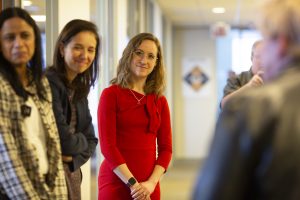By Sara Hunter, MD
When I applied for the American Board of Medical Specialties (ABMS) Visiting Scholar Program (VSP), I wondered if I was making a mistake. I was about to graduate fellowship, start as staff physician, and enter a new stage in my life. Furthermore, I was worried I would not be able to balance my new staff responsibilities, raise children, and keep up with the demands of a yearlong scholar program. Fortunately, I was mistaken.

The ABMS Visiting Scholars Program is a one-year program for early career physicians, researchers, and other healthcare professionals from across the medical spectrum. The goal is for scholars to create and implement a research project geared toward improving diagnostic excellence within specialties, competency-based medical education, physician engagement with quality improvement, or another research priority of the ABMS community. To assist with the research, grant funding is provided to cover internal resources and travel expenses.
The program consists of monthly virtual meetings where scholars provide updates on their research projects and ABMS leadership offers insight on various topics, such as developing your physician identity, optimizing abstracts and publications, and creating plans for future related research. During the year, scholars have the opportunity to visit the ABMS headquarters in Chicago to see the inner workings of the organization and meet the ABMS leadership and other scholars in person. At the end of the year, scholars are invited to present their work to the greater medical board community at the ABMS annual conference.
After applying to the program, I immediately saw that the VSP was tailored specifically toward early career physicians to act as a stepping stone for future, larger endeavors. The grant application is formatted to help you formulate background evidence for your proposal, methodology for your idea, a data analysis plan, and questions your project will address. These will ultimately become the “introduction” and “materials and methods” sections for a subsequent manuscript or presentation. Throughout the year, you share the successes and roadblocks of implementing these projects with your co-scholars and learn how they managed to overcome some of the obstacles you might be facing.
While I am proud I completed my research in the one-year span and learned about my colleagues’ projects, I believe that was not the culmination of this program. The ABMS VSP allowed me to create connections and bonds with other physicians in similar stages of their careers, understand and tackle the nuances of a staff work-life balance (e.g., no, the world will not end if your child joins you on the monthly ABMS Teams meeting), and start to understand how each of our endeavors impacts the culture of our specialty and medicine as a whole. Many times throughout the year, we discussed the impact of COVID, virtual board exams, and updates on maternity leave policies on the culture of medicine. I was initially surprised to learn that the ABMS meticulously plans and accounts for changes in the physician lifestyle arising from updates in certification standards, continuing education, and leave policies. However, I have started to appreciate how guideline adjustments on a national scale or even departmental level alter the culture of the affected group.
Finally, to anyone even slightly interested in the ABMS VSP, I encourage you to apply. The demands are relatively minimal, the rewards are fantastic, and you will find yourself a better physician and person from the shared knowledge and experiences with the growing ABMS VSP community.
Sara Hunter, MD, is a diagnostic radiologist at the Cleveland Clinic.


